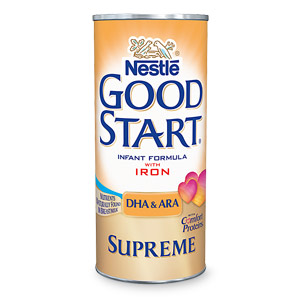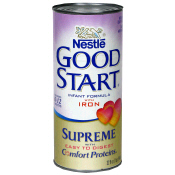|
What is the difference between these two?
| Posted By |
Message |
preciouslove
I love my DS!!!
Member since 5/05 9340 total posts
Name:
Blank
|
What is the difference between these two?
Isn't it the same milk?
Image Attachment(s):


|
Posted 11/15/06 10:56 AM  |
| |
|
Long Island Weddings
Long Island's Largest Bridal Resource |
-Laurie-
Hi!

Member since 5/05 2536 total posts
Name:
|
Re: What is the difference between these two?
Orange has DHA/ARA included the purple can doesn't.
|
Posted 11/15/06 11:02 AM  |
| |
|
Faithx2
All good things in 2016!!

Member since 8/05 20181 total posts
Name:
|
Re: What is the difference between these two?
The DHA and ARA.
I see formulas on the market that contain ingredients called DHA and ARA. What are these substances?
DHA is docosahexaenoic acid and ARA is arachidonic acid. Both are long-chain polyunsaturated fatty acids. The body can make DHA and ARA from certain other dietary fatty acids, which are found in plant oils and other sources; however, DHA and ARA are also consumed directly in the diet.
What foods contain the fatty acids DHA (docosahexaenoic acid) and ARA (arachidonic acid)?
DHA is contained in varying amounts in fish oils, with oils from cold-water fish containing higher amounts. DHA and ARA are also found in some algae and fungi, eggs, and in human breast milk. Some manufacturers make dietary supplements containing DHA and ARA.
Why is there interest in adding DHA and ARA to infant formulas?
While infants can make these fatty acids from other ("essential") fatty acids in their diet, including the fatty acids in infant formulas, some studies suggest that some infants, such as premature infants, may benefit from direct consumption. Other studies suggest no benefit. It is known that long-chain polyunsaturated fatty acids (DHA in particular) accumulate in brain and eye of the fetus, especially during the last trimester of pregnancy. These fatty acids are also found in the fat of human breast milk. Blood levels of DHA and ARA are typically higher in breast-fed infants than in infants fed formulas not containing these fatty acids. For these reasons, some infant formula manufacturers and consumers are interested in providing DHA and ARA directly to infants. These manufacturers and consumers argue that adding oils containing these fatty acids to the fats and oils already in infant formula will provide an infant with both pre-formed DHA and ARA and the essential fatty acids an infant needs to make its own DHA and ARA.
What is the evidence that addition of DHA and ARA to infant formulas is beneficial?
The scientific evidence is mixed. Some studies in infants suggest that including these fatty acids in infant formulas may have positive effects on visual function and neural development over the short term. Other studies in infants do not confirm these benefits. There are no currently available published reports from clinical studies that address whether any long-term beneficial effects exist.
I understand that oils containing DHA and ARA have been added to infant formulas for several years in other countries. Isn't there information from those countries on any long-term benefits or adverse consequences of formulas containing these fatty acids?
Systematic monitoring efforts are not in place to collect and analyze information on effects of infant formulas containing DHA and ARA in countries where these formulas are in use.
Why has FDA asked infant formula manufacturers to do postmarket surveillance of infants consuming formulas containing ARA or DHA?
These are new ingredients that were not used in infant formulas in this country before early 2002, and infant formulas containing ARASCO (ARA Single Cell Oil) and DHASCO (DHA Single Cell Oil) have been marketed in other countries for only a few years. FDA views any evaluation of the safety of use of new food ingredients such as DHASCO and ARASCO as a time-dependent judgment that is based on general scientific knowledge as well as specific data and information about the ingredient. Therefore, scientific data that become available after specific products containing a new ingredient enter the market must be considered as a part of the totality of information about the ingredient. Pre-market clinical studies evaluating the effects of infant formulas containing DHASCO and ARASCO on physical growth and some aspects of development are short-term studies, while some studies suggest that feeding of infant formulas with oils containing DHA and ARA to infants may have long-term effects on growth and development. For all these reasons, manufacturers have been asked to closely monitor these new infant formulas in the marketplace.
|
Posted 11/15/06 11:02 AM  |
| |
|
preciouslove
I love my DS!!!
Member since 5/05 9340 total posts
Name:
Blank
|
Re: What is the difference between these two?
Ahhh didn't see that...thanks!
|
Posted 11/15/06 11:04 AM  |
| |
|
Potentially Related Topics:
Currently 952735 users on the LIFamilies.com Chat
|










